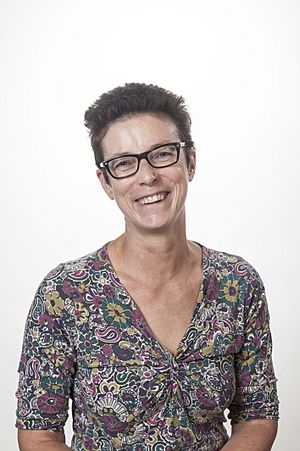Anne Osbourn facts for kids
Quick facts for kids
Anne Osbourn
|
|
|---|---|

Osbourn in 2015
|
|
| Born |
Anne Elisabeth Osbourn
|
| Education | Bingley Grammar School |
| Alma mater | Durham University University of Birmingham |
| Scientific career | |
| Fields | Natural products |
| Institutions | John Innes Centre University of East Anglia Sainsbury Laboratory New Phytologist |
| Thesis | Host adaptation and variation in septoria nodorum (1985) |
Anne Elisabeth Osbourn is a professor and a science leader at the John Innes Centre. She studies how plants make special chemicals, called natural products. She made an important discovery: the genes that help plants make these chemicals are often found grouped together.
Professor Osbourn is also great at sharing science with everyone. She writes poetry and started the Science, Art and Writing (SAW) Initiative. In 2022, she became a member of the National Academy of Sciences.
Contents
Early Life and Education
Anne Osbourn grew up in West Yorkshire, England. Her parents were both teachers of English literature. She became very interested in plants when she was a child.
She went to Bingley Grammar School and finished in 1979. Then, she studied botany, which is the study of plants, at Durham University. She earned her first degree in 1982.
Later, she went to the University of Birmingham for her PhD. She studied how a plant disease called Septoria nodorum adapts to its hosts.
Research and Discoveries
In 1985, Professor Osbourn moved to Norwich to work at the John Innes Centre. She later joined The Sainsbury Laboratory and became a group leader in 1999. In 2005, she returned to the John Innes Centre.
Plant Defense Chemicals
Her early work focused on chemicals called saponins. These are natural products that help plants defend themselves. Professor Osbourn studies how these natural products interact with other living things.
Genes in Clusters
She has done a lot of research on how plants make chemicals called triterpenes. She found that the genes involved in making these chemicals are often organized in special groups, like small teams. This discovery helps scientists find new natural products by looking at a plant's genetic code.
These natural products include terpenes. Terpenes can be used in many ways, such as in medicines, food, and manufacturing. Her research has received funding from the Biotechnology and Biological Sciences Research Council (BBSRC).
Leading Research Centers
In 2006, Professor Osbourn became an Honorary Professor at the University of East Anglia. Since 2014, she has been a director at the OpenPlant Synthetic Biology Research Centre. This center studies synthetic biology, which is about designing and building new biological parts.
She also led the Norwich Research Park Industrial Biotechnology Alliance from 2013 to 2019. Today, she continues to lead a research group at the John Innes Centre. They work on understanding plant natural products and how to use them.
Sharing Science with Everyone
Professor Osbourn loves to share her passion for science. In 2004, she wrote poetry about her life as a plant scientist. This experience inspired her to create the Science, Art and Writing (SAW) Trust in 2005.
The SAW Trust
The SAW Trust is a charity that helps people learn about science in creative ways. It brings together scientists, writers, and artists. They work with young people, even those in elementary schools.
The SAW Trust has a big educational program in China. Over 1,000 children there have taken part in SAW projects. In 2016, Professor Osbourn also participated in an exchange program with the Vietnam Academy of Science and Technology.
Awards and Recognition
Professor Osbourn has received many awards and honors for her work. She was elected to AcademiaNet in 2014. She also helps edit important science journals like New Phytologist and Molecular Plant.
In 2003, she received a medal from the University of Helsinki. She was elected a Fellow of the Linnean Society in 2018. In 2019, she became a Fellow of the Royal Society (FRS), which is a very high honor for scientists. She is the thirtieth researcher from the John Innes Centre to receive this award.
In 2020, she was given the title of Officer of the Order of the British Empire (OBE). This was for her great contributions to plant science.
Images for kids


